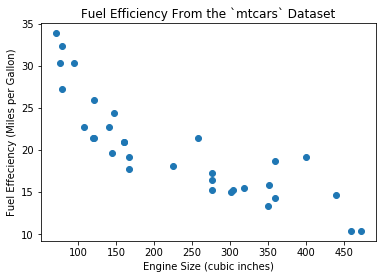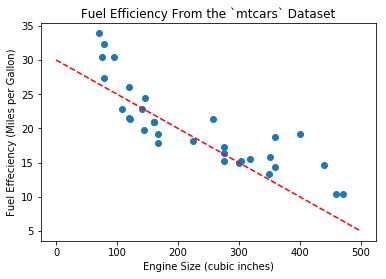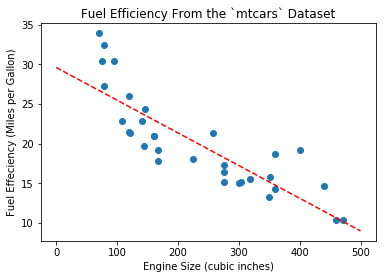Linear regression is one of the simplest machine learning algorithms and is the best practice for beginners. In this post I will guide you step by step creating a Linear Regression model from scratch.
What is Linear Regression?
Let’s start with some data. Suppose we measured different car models and collected some data with respect to their fuel effeciency and engine size. (If you wonder, this is the mtcars dataset in R language.) Let’s load the data and shows the first 5 rows of the data, in which mpg is the fuel efficiency in Miles per Gallon and disp is the engine size in cu.in. :
import pandas as pd
import numpy as np
import matplotlib.pyplot as plt
df = pd.read_csv('https://gist.githubusercontent.com/seankross/a412dfbd88b3db70b74b/raw/5f23f993cd87c283ce766e7ac6b329ee7cc2e1d1/mtcars.csv')
df[['model', 'disp', 'mpg']].head()
| model | disp | mpg | |
|---|---|---|---|
| 0 | Mazda RX4 | 160.0 | 21.0 |
| 1 | Mazda RX4 Wag | 160.0 | 21.0 |
| 2 | Datsun 710 | 108.0 | 22.8 |
| 3 | Hornet 4 Drive | 258.0 | 21.4 |
| 4 | Hornet Sportabout | 360.0 | 18.7 |
We can plot disp and mpg as Figure 1.
plt.scatter(x=df.disp, y=df.mpg, marker='o')
plt.xlabel('Engine Size (cubic inches)')
plt.ylabel('Fuel Effeciency (Miles per Gallon)')
plt.title('Fuel Efficiency From the `mtcars` Dataset')
plt.show()

mtcars DatasetNow we need a model which outputs the fuel effeciency given the engine size as input. Why? Because if we have a new engine for which we want to know the efficiency, the plot in Figure 1 will not help.
One of the simplest models is called Linear Regresion model, or a straight line in the form of \(y = wx + b\), in which \(w, b\) are coefficients. Intuitively we can draw the line as Figure 2.
plt.scatter(x=df.disp, y=df.mpg, marker='o')
plt.xlabel('Engine Size (cubic inches)')
plt.ylabel('Fuel Effeciency (Miles per Gallon)')
plt.title('Fuel Efficiency From the `mtcars` Dataset')
x = np.linspace(0, 500)
y = -0.05 * x + 30.0
plt.plot(x, y, '--', color='r')
plt.show()

The equation for the line above is \(y = -0.05x + 30.0\). With this model, we can compute efficiency for any new engine. For example given engine size 200 cu.in., we can predict that fuel effeciency is \(-0.05 \times 200 + 30.0 = 20.0 mpg\).
Error, or Loss
You may want to ask: is \(y = -0.05x + 30.0\) the correct answer? Since most of the given data points are not on this line (practically it is impossible to draw a straight line across all the points), we could alternatively ask: Is this the best line we can draw? Or, how good is this model for prediction?
We need a measurement of the “accuracy” of this model. For each data point we have, we compute the difference between the actual effeciency and the predict effeciency from the model. In math language, we compute:
$$y – \hat{y} = y – (-0.05x + 30.0)$$
In which \(\hat{y}\) pronounces “y hat” and denotes the effeciency predicted by the model given x (engine size). Then we compute the summation of the squared difference for all the data points. The reason for taking square is to prevent positive and negative numbers from cancelling each other.
We also added 1/2 to the equation to make future numerical computation easier.
$$ \begin{align*}L &= \frac{1}{2n}\big((y_1 – \hat{y}_1)^2 + (y_2 – \hat{y}_2)^2 + \cdots + (y_n – \hat{y}_n)^2\big) \\
&= \frac{1}{2n}\sum_{i=1}^n (y_i – \hat{y}_i)^2.
\end{align*}
$$
This \(L\), called “loss”, or “error”, is the measurement of the accuracy of the model. The formula we used here is called “MSE” (Mean Squared Error).
Now let us compute the error:
np.mean(np.square(df.mpg - (-0.05 * df.disp + 30.0)))
13.705833593749997Minimize Loss
In order to find the optimal model, we want the loss to be minimal. Let us take a look at the equation of the loss function:
$$L = \frac{1}{2n} \sum_{i=1}^n (y_i – \hat{y}_i) ^ 2 = \frac{1}{2n}\sum_{i=1}^n (y_i – (wx_i + b)) ^ 2 $$
Our goal is to find the optimal line, or coefficients \(w, b\), by minimize loss \(L\). In this task, \(x_i, y_i\) are the data points provided by our mtcars data, which we called training data. So our goal can be represented as:
$$
\begin{align}
&\text{Given training data }\mathcal{D} = \{ (x_1, y_1), (x_2, y_2), \cdots, (x_n, y_n) \}, \\
&\text{find }w, b \text{ to minimize }L.
\end{align}
$$
Note that the variables in above problem are \(w, b\), not \(x_i, y_i\)!
This function is a convex function (proof is out of scope), so to find the minimum, we only need to take the partial derivative with respect to \(w, b\) and let them equal to zero, then solve the coefficients \(w, b\).
Here is the step-by-step solution:
$$
\begin{align*}
\frac{\partial E}{\partial w} &= \frac{\partial}{\partial w} \frac{1}{2n}\sum (y_i – (wx_i + b)) ^ 2
= \frac{1}{2n} \sum \frac{\partial}{\partial w}\big(y_i – (wx_i + b)\big)^2 \\
&= \frac{1}{2n} \sum 2 (y_i – wx_i – b)(-x_i)
= \frac{1}{n} \sum (wx_i + b – y_i) \cdot x_i, \\
\\
\frac{\partial E}{\partial b} &= \frac{\partial}{\partial b} \frac{1}{2n}\sum (y_i – (wx_i + b)) ^ 2
= \frac{1}{2n} \sum \frac{\partial}{\partial b}\big(y_i – (wx_i + b)\big)^2 \\
&= \frac{1}{2n} \sum 2 (y_i – wx_i – b)(-1)
= \frac{1}{n} \sum (wx_i + b – y_i). \\
\end{align*}
$$
Let both equal to zero, we have
$$
\frac{\partial E}{\partial w} = \frac{1}{n} \sum (wx_i + b – y_i) \cdot x_i = 0,\\
\frac{\partial E}{\partial w} = \frac{1}{n} \sum (wx_i + b – y_i) = 0.
$$
Solve this equation system we have
$$
w = \frac{n \sum x_iy_i – \sum x_i \sum y_i}{n \sum x_i^2 – \big(\sum x_i \big) ^2}, \;
b = \frac{1}{n}\big(\sum y_i – w \sum x_i).
$$
The following code will compute \(w, b\) for us:
n = len(df) x = df.disp y = df.mpg sum_x = np.sum(x) sum_y = np.sum(y) sum_xy = np.sum(x * y) sum_x2 = np.sum(x * x) w = (n * sum_xy - sum_x * sum_y) / (n * sum_x2 - sum_x * sum_x) b = (sum_y - w * sum_x) / n print(w, b)
-0.041215119962786144 29.59985475616395These are the optimal coefficients for \(w, b\) and the line equation is \(y = -0.041215 x + 29.5999\). We can plot the line with these new coefficients, as in Figure 3:

Linear Regression in Matrix Form
In previous section we saw that computing the partial derivatives with respect to \(w, b\) involves pretty complicated mathmatics. Fortunately, we can use vectors and matrices to make the calculation easier.
First, let us rewrite the line equation \(y = wx + b\) as this form:
$$ y = \begin{bmatrix}1 & x\end{bmatrix} \begin{bmatrix} b \\ w\end{bmatrix} $$
This is a trick to merge \(w, b\) into one vector variable so that we don’t need to compute partial derivates twice.
Denote \(\begin{bmatrix}b & w\end{bmatrix}^\intercal\) as \(\mathbf{w}\) and \(\begin{bmatrix}1 & x \end{bmatrix}^\intercal\) as \(\mathbf{x}\) (use bold letters to show they are vectors), then the equation can be written as:
$$ y = \mathbf{x}^\intercal \mathbf{w} $$
Now we consider all the data points \((x_i, y_i), \forall i \in \{1 \cdots n\} \). The loss function can be written as:
$$
\begin{align}
L &= \frac{1}{2n}\sum_{i=1}^n (y_i – \hat{y}_i)^2 \\
&= \frac{1}{2n} \big((y_1 – \hat{y}_1)^2 + \cdots + (y_n – \hat{y}_n)^2\big) \\
&= \frac{1}{2n} \lVert \mathbf{y} – \hat{\mathbf{y}} \rVert ^ 2 \\
&= \frac{1}{2n} \lVert \mathbf{y} – \mathbf{X}\mathbf{w} \rVert ^ 2.
\end{align}
$$
Here we used some vector and matrix notations:
$$ \mathbf{y} = \begin{bmatrix}y_1 \\ y_2 \\ \vdots \\ y_n\end{bmatrix}, \;
\mathbf{X} = \begin{bmatrix}\mathbf{x}_1^\intercal \\ \mathbf{x}_2^\intercal \\ \vdots \\ \mathbf{x}_n^\intercal \end{bmatrix}
= \begin{bmatrix}1 & x_1 \\ 1 & x_2 \\ \vdots & \vdots \\ 1 & x_n \end{bmatrix}.
$$
And the notation \(\lVert \cdot \rVert\) is the \(L^2\) norm. Thus \(\lVert \mathbf{y} – \hat{\mathbf{y}} \rVert ^ 2 = \sum (y_i – \hat{y}_i)^2 \), and it is easy to validate that this equation is equavilent to the one we used in previous section.
Next, we use the same approach to find the minimal loss by letting the gradient (the vector consists of partial derivatives of each component) equal to zero. To compute the gradient, we write the equation as:
$$
\begin{align}
L &= \frac{1}{2n} \lVert \mathbf{y} – \mathbf{Xw} \rVert ^ 2
= \frac{1}{2n} (\mathbf{y} – \mathbf{Xw})^\intercal (\mathbf{y} – \mathbf{Xw}) \\
&= \frac{1}{2n} \big(
\mathbf{y}^\intercal \mathbf{y} –
\mathbf{y}^\intercal \mathbf{Xw} –
(\mathbf{Xw})^\intercal \mathbf{y} +
(\mathbf{Xw})^\intercal (\mathbf{Xw})
\big) \\
&= \frac{1}{2n} \big(
\mathbf{y}^\intercal \mathbf{y} –
2 \mathbf{w}^\intercal \mathbf{X}^\intercal \mathbf{y} +
\mathbf{w}^\intercal \mathbf{X}^\intercal \mathbf{Xw}
\big).
\end{align}
$$
Now we compute its gradient.
$$
\begin{align}
\nabla_w L = \frac{1}{2n} \nabla_w \big(\mathbf{y}^\intercal \mathbf{y} –
2 \mathbf{w}^\intercal \mathbf{X}^\intercal \mathbf{y} +
\mathbf{w}^\intercal \mathbf{X}^\intercal \mathbf{Xw}
\big) = 0.
\end{align}
$$
To calculate the gradient with respect to \(\mathbf{w}\):
- The first term \(\mathbf{y}^\intercal \mathbf{y}\) is constant with respect to \(\mathbf{w}\), thus the gradient is 0;
- The gradient of the second term \(-2 \mathbf{w}^\intercal \mathbf{X} ^\intercal \mathbf{y}\) is \(-2 \mathbf{X}^\intercal \mathbf{y}\);
- The gradient of the third term \(\mathbf{w}^\intercal \mathbf{X}^\intercal \mathbf{Xw}\) is \(2\mathbf{X}^\intercal \mathbf{Xw}\).
Thus the gradient of loss is:
$$
\begin{align}
& 0 – 2\mathbf{X}^\intercal \mathbf{y} + 2\mathbf{X}^\intercal \mathbf{Xw} = 0. \\
&\Rightarrow \mathbf{X}^\intercal \mathbf{Xw} = \mathbf{X}^\intercal \mathbf{y}. \\
&\Rightarrow \mathbf{w} = \big(\mathbf{X}^\intercal \mathbf{X}\big)^{-1} \mathbf{X}^\intercal \mathbf{y}.
\end{align}
$$
This is the analytic solution for the linear regression model. We can use this equation to find the optimal model:
n = len(df) X = np.vstack([np.ones([n]), df.disp]).T y = df.mpg # @ is a new operator in Python 3 for matrix multiplication w = np.linalg.inv(X.T @ X) @ X.T @ y print(w)
array([29.59985476, -0.04121512])We got the same results as previous section, with only one line of code!
Matrix form is very useful and makes calculation much easier, especially for multivariant linear regression model, which we will cover in the next section.
Multivariant Linear Regression
We just explained how to build a linear regression model to predict fuel efficiency from engine size. However, fuel effeciency is a complex phenomenon that may have many contributing factors other than engine size, so when creating linear regression model, using more factors may result in a more robust model. Here the “contributing factors” are called features. The linear model we just discussed includes only one feature disp. In order to consider multiple features, we need to implement multivariant linear regression.
The linear regression model we used in previous section was simply a straight line in 2-D space:
$$y = wx + b$$
Here \(x\) is the input feature and \(y\) is the predicted output. In order to use multiple features, we simply change the equation to this form:
$$y = b + w_1 x_1 + w_2 x_2 + \cdots + w_d x_d$$
where \(x_1, x_2, \cdots\) are input features, and \(d\) is the number of features. This equation is a hyperplane in a \(d+1\) dimension space.
Since \(b, w_1, w_2, \cdots\) are all coefficients, we generally write \(b\) as \(w_0\), and add a dummy input \(x_0 = 1\) which is a constant, to get a more generic equation:
$$
\begin{align}
y &= w_0 x_0 + w_1 x_1 + w_2 x_2 + \cdots + w_d x_d \\
\text{Input: } \mathbf{x} &= (x_0 = 1, x_1, x_2, \cdots, x_d) \in \mathbb{R}^{d+1} \\
\text{Model Parameters}: \mathbf{w} &= (w_0, w_1, w_2, \cdots, w_d) \in \mathbb{R}^{d+1}
\end{align}
$$
This can be written in vector form:
$$ y = \mathbf{x}^\intercal \mathbf{w}$$
Now we consider multiple training data points \(\mathcal{D} = \{ (\mathbf{x}_1, y_1), \cdots, (\mathbf{x}_n, y_n) \}\). Using the following notation:
$$ \mathbf{y} = \begin{bmatrix}y_1 \\ y_2 \\ \vdots \\ y_n\end{bmatrix}, \;
\mathbf{X} = \begin{bmatrix}\mathbf{x}_1^\intercal \\ \mathbf{x}_2^\intercal \\ \vdots \\ \mathbf{x}_n^\intercal \end{bmatrix}
= \begin{bmatrix}1 & x_{11} & x_{12} & \cdots & x_{1d} \\
1 & x_{21} & x_{22} & \cdots & x_{2d} \\
\vdots & \vdots & \vdots & \ddots & \vdots \\
1 & x_{n1} & x_{n2} & \cdots & x_{nd} \end{bmatrix},
$$
We can write the linear regression model as:
$$\mathbf{y} = \mathbf{Xw}.$$
Now we can use the same procedure in previous post to find the analytic solution for this equation:
$$\mathbf{w} = \big(\mathbf{X}^\intercal \mathbf{X}\big)^{-1} \mathbf{X}^\intercal \mathbf{y}.$$
With this equation we can easily make a multivariant linear regression model:
import pandas as pd
import numpy as np
df = pd.read_csv('https://gist.githubusercontent.com/seankross/a412dfbd88b3db70b74b/raw/5f23f993cd87c283ce766e7ac6b329ee7cc2e1d1/mtcars.csv')
n = len(df)
columns = ['cyl', 'disp', 'hp', 'drat', 'wt', 'qsec', 'vs', 'am', 'gear', 'carb']
y = df['mpg']
X = df[columns]
# Add x_0 for each x
X = np.hstack([np.ones([n, 1]), X])
w = np.linalg.inv(X.T @ X) @ X.T @ y
print(w)
The output is:
[12.30337416 -0.11144048 0.01333524 -0.02148212 0.78711097 -3.71530393
0.82104075 0.31776281 2.52022689 0.65541302 -0.19941925]This means the equation of the model is:
$$
\begin{align}
y = &12.30337416 – 0.11144048 \cdot \text{cyl} + 0.01333524 \cdot \text{disp} – 0.02148212 \cdot \text{hp} + \\
& 0.78711097 \cdot \text{drat} – 3.71530393 \cdot \text{wt} + 0.82104075 \cdot \text{qsec} + 0.31776281 \cdot \text{vs} + \\
&2.52022689 \cdot \text{am} + 0.65541302 \cdot \text{gear} – 0.19941925 \cdot \text{carb}.
\end{align}
$$
Thanks for reading, and I hope this article has explained the details of the simplest linear regression model!
Originally posted at https://hackernoon.com/linear-regression-from-scratch-1c22ff292592.

Webmentions
[…] cost of sildenafil 50mg […]
[…] buy cialis online canadian pharmacy […]
[…] coupons for cialis […]
[…] cialis pills for men […]
[…] where to buy cialis cheap […]
[…] figral sildenafil 100mg […]
[…] ginseng root for erectile dysfunction […]
[…] how much is cialis in mexico […]
[…] cialis 40 mg for sale […]
[…] viagra 25 mg uk […]
[…] purchase clomid […]
[…] rybelsus patient information […]
periactin and pregnancy
periactin and pregnancy
zanaflex and reflux
zanaflex and reflux
muscle relaxer lioresal
muscle relaxer lioresal
what are the side effects of taking meloxicam
what are the side effects of taking meloxicam
is maxalt stronger than imitrex
is maxalt stronger than imitrex
taking mebeverine tablets
taking mebeverine tablets
ibuprofen chromatography
ibuprofen chromatography
etodolac ibuprofen together
etodolac ibuprofen together
gabapentin tabletki
gabapentin tabletki
celecoxib celebrex contraindications
celecoxib celebrex contraindications
celebrex logo pdf
celebrex logo pdf
paroxetine with tadalafil
paroxetine with tadalafil
vardenafil hcl 20mg tab vs viagra
vardenafil hcl 20mg tab vs viagra
tadalafil and tamsulosin
tadalafil and tamsulosin
sildenafil citrate vs sildenafil
sildenafil citrate vs sildenafil
sildenafil 20 mg dosage for erectile dysfunction
sildenafil 20 mg dosage for erectile dysfunction
levitra pill
levitra pill
pharmacy shorted me vicodin
pharmacy shorted me vicodin
levitra sales online
levitra sales online
how much cialis should i take
how much cialis should i take
sertraline and sildenafil together reddit
sertraline and sildenafil together reddit
maximum dose of sildenafil per day
maximum dose of sildenafil per day
uk pharmacy no prescription
uk pharmacy no prescription
levitra seizure medication
levitra seizure medication
metformin lactic acidosis symptoms
metformin lactic acidosis symptoms
how long for keflex to work on tooth infection
how long for keflex to work on tooth infection
can you drink while taking valacyclovir
can you drink while taking valacyclovir
flexeril and gabapentin
flexeril and gabapentin
tadalafil side effects long term
tadalafil side effects long term
stromectol tablets uk
stromectol tablets uk
viagra over the counter canada
viagra over the counter canada
vardenafil vs cialis
vardenafil vs cialis
viagra vs cialis vs levitra
viagra vs cialis vs levitra
sildenafil 100 mg para que sirve
sildenafil 100 mg para que sirve
buy sildenafil online
buy sildenafil online
where to buy ivermectin cream
where to buy ivermectin cream
abilify mycite
abilify mycite
glimepiride metformin sitagliptin
glimepiride metformin sitagliptin
spironolactone 25 mg uses
spironolactone 25 mg uses
does amitriptyline help with anxiety
does amitriptyline help with anxiety
repaglinide pictures
repaglinide pictures
acarbose wirkung
acarbose wirkung
are semaglutide and ozempic the same
are semaglutide and ozempic the same
remeron abuse
remeron abuse
actos brain
actos brain
bupropion extended release
bupropion extended release
what is buspar used for
what is buspar used for
augmentin davis pdf
augmentin davis pdf
can i take ibuprofen with celebrex
can i take ibuprofen with celebrex
what is aspirin made of
what is aspirin made of
side effects of allopurinol 100 mg
side effects of allopurinol 100 mg
diltiazem classification
diltiazem classification
contrave manufacturer coupon
contrave manufacturer coupon
side effects of ezetimibe tablets
side effects of ezetimibe tablets
effexor sexual side effects
effexor sexual side effects
what is cozaar prescribed for
what is cozaar prescribed for
what is flexeril used for
what is flexeril used for
depakote drug interactions
depakote drug interactions
allergic reaction to bactrim after 7 days
allergic reaction to bactrim after 7 days
lexapro reviews anxiety
lexapro reviews anxiety
gabapentin injection
gabapentin injection
does cephalexin interfere with birth control
does cephalexin interfere with birth control
buspar and zoloft
buspar and zoloft
zofran and fluoxetine
zofran and fluoxetine
[…] clindamicina drug[…]
clindamicina drug